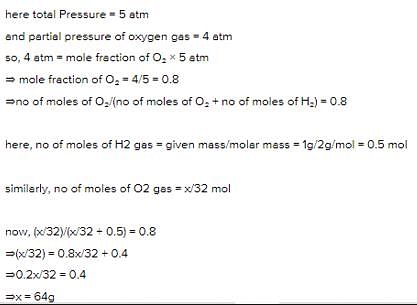Test: Ideal Gas Equation & Dalton's Law of Partial Pressure (Old NCERT) - NEET MCQ
16 Questions MCQ Test NCERT Based Tests for NEET - Test: Ideal Gas Equation & Dalton's Law of Partial Pressure (Old NCERT)
Direction (Q. Nos. 1-12) This section contains 12 multiple choice questions. Each question has four choices (a), (b), (c) and (d), out of which ONLY ONE option is correct.
Q.
The vapour pressure of liquid water is 23.8 torr at 25°C. By what factor does the molar volume of water increases as it vaporises to form an ideal gas under these conditions? The density of liquid water is 0.997 g cm-3 at 298 K ?
The vapour pressure of liquid water is 23.8 torr at 25°C. By what factor does the molar volume of water increases as it vaporises to form an ideal gas under these conditions? The density of liquid water is 0.997 g cm-3 at 298 K ?
A gas at a pressure of 5.0 bar is heated from 0°C to 546°C and is simultaneously compressed to one-third of its original volume. Hence, final pressure is
A 8.3 L cylinder contains 128 . 0 g O2 gas at 27°C. What mass of O2 gas must be released to reduce the pressure to 6.0 bar ?
N2 gas under the given state I is to be changed to state II. Thus, N2 escaped from I is
1 g H2 gas and x g O2 gas exert a total pressure of 5 atm. At a given temperature partial pressure of O2 gas is 4 atm. This O2 in the mixture is
The average molar mass of the vapour above solid NH4CI is nearly 26.75 g mol-1.
Thus, vapour consists of (mole fraction)
Pressure of 1 g of an ideal gas A at 300 K is found to be 2 bar. When 2 g of another ideal gas B is introduced in the same flask at the same temperature, pressure becomes 3 bar. Thus,
Total pressure of a mixture of H2 and O2 is 1.00 bar. The mixture is allowed to react to form water, which is completely removed to leave only pure l-l2 at a pressure of 0.35 bar. Assuming ideal gas behaviour and that all pressure measurements were made under the same temperature and volume conditions, the composition of the original mixture is
The composition of air inhaled by a human is 21 % by volume O2 and 0.03% CO2 and that of exhaled air is 16% O2 and 4.03% CO2. Assuming a typical volume of 6200 L day -1, moles of O2 used and CO2 generated by the body at 37°C and 1.00 bar are (assume ideal behaviour)
The following arrangement of flasks is set up. Assuming no temperature change, determine the final pressure inside the system after all stopcocks are opened. The connecting tube has zero volume.
1.00 mole sample of O2 and 3.00 moles sample of H2 are mixed isothermally in a 125.3 L container at 125°C. Gaseous mixture undergoes reaction to form water vapours. Assume ideal gas behaviour total pressure before and after H2O (g) is formed is are respectivel
When NO2 is cooled to room temperature, some of it reacts to form a dimer N2O4 through the reaction,
In a reaction, 15.2 g of NO2 is placed in a 10.0 L flask at high temperature and the flask is cooled to 25°C. The total pressure is measured to be 0.500 atm. Thus, partial pressure of NO2 is found to be
Direction (Q. Nos. 13 and 16) This section contains 4 questions. when worked out will result in an integer from 0 to 9 (both inclusive)
Q.
A toy balloon originally held 1.00 g helium gas and had a radius of 10.0 cm.
During the night 0.25 g of the gas effused from the balloon. Assuming the ideal gas behaviour under the constant pressure and temperature conditions, what was the radius of the balloon the next morning? (Express result in cm.)
What will be the temperature difference needed in a hot air balloon to lift 1.00 kg of mass ? Assume that the volume of the balloon is 100 m3, the temperature of the ambient air is 298 K, the pressure is 1.00 bar, and the air is an ideal gas with average molar mass of 29 g mol-1.
Iron forms a series of compounds of the type Fex (CO)y. In air, they are oxidised to Fe2O3 and CO2 gas. After heating a 0.142 g sample in air, you isolate the CO2 in a 1.50 L flask at 25°C. The pressure of the gas is 44.9 mm Fig. What will be the value of y/x in the simplest empirical formula of Fex(CO)y? [Atomic mass of Fe = 56]
To an evacuated vessel with movable piston under external pressure of 1 atm, 0.1 mole of Fie and 0.1 mole of an unknown compound (vapour pressure 0.68 atm at 0°C) are introduced. Considering the ideal gas behaviour, the total volume (in litre) of the gases 0°C is close to...
[IITJEE 2011]
|
748 tests
|





















